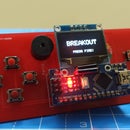Introduction: Electricity Generation From Piezoelectric Element
Hello Instructables !
In this Instructables we will generate electricity from piezoelectric element by using the phenomenon
of PIEZOELECTRIC EFFECT
PIEZOELECTRIC EFFECT
Piezoelectric Effect is the ability of certain materials to generate an electric charge in response to applied mechanical stress .The piezoelectric crystals exhibit the piezoelectric effect. This piezoelectric effect having two properties. First one is the direct piezoelectric effect which means that material has ability to convert mechanical strain into electrical charge. Second one is the converse effect, in which the applied electrical potential converted into mechanical strain energy. In this project we are using direct piezoelectric effect to generate electricity
Step 1: Concept
PIEZO ELECRIC TRANSDUCER
A piezoelectric plate is a device that uses the piezoelectric effect to measure pressure, acceleration, strain or force by converting them to an electrical charge. Piezoelectricity is the electricity generated by piezo element by effect called the piezoelectric effect.It is the ability of certain materials to generate an AC (alternating current) voltage when subjected to mechanical stress or vibration, or to vibrate when subjected to an AC voltage, or both. The most common piezoelectric material is quartz. Certain ceramics, Rochelle salts, and various other solids also exhibit this effect. When a sound wave strikes one or both sides of the plates, the plates vibrate. The crystal picks up this vibration, which it translates into a weak AC voltage. Therefore, an AC voltage arises between the two metal plates, with a waveform similar to that of the sound waves. Conversely, if an AC signal is applied to the plates, it causes the crystal to vibrate in sync with the signal voltage. As a result, the metal plates also vibrates and produce an acoustic disturbance.
VOLTAGE AMPLIFICATION
In our project we used Villard Cased to convert AC supply to DC and amplify the voltage.We chose Villard cascade because it rectify and amplify the input from the source simultaneously by using diodes and capacitor.
VILLARD CASCADE
A voltage multiplier is an electrical circuit that converts AC electrical power from a lower voltage to a higher DC voltage, typically using a network of capacitors and diodes.Voltage multipliers can be used to generate a few volts for electronic appliances, to millions of volts for purposes such as high-energy physics experiments and lightning safety testing. The most common type of voltage multiplier is the half-wave series multiplier, also called the Villard cascade.
Step 2: Components Required
COMPONENTS:
- Piezoelectric elements
- Hookup wire
- Capacitors
- Diodes
- PVC sheet
- Foam Push ups
- Glue
TOOLS:
- Soldering Iron
- Drem tool
Step 3: Construction
1.Mark the feet size on PVC sheet and cut it accordingly
2.Place piezo elements on the pvc sheet and mark it to make holes
3.Make holes into the PVC according to the marking
4.Stick the piezo elements in the sandwiching manner with hot glue
Precautions:
AVOID CONTACT OF PIEZO ELEMENTS EACH OTHER
Step 4:
In the project we used piezoelectric transducer of ceramic type. Piezo transducer generate AC voltage when we apply pressure on piezoelectric transducer. As AC voltage cannot sum up each other, we have to convert AC voltage to DC voltage. We are converting AC to DC because AC voltage cannot sum up but DC voltage can sum up in series. But in process of converting AC to DC we may loose some energy. If we use full wave reflection bridge to convert AC to DC. We get approx. 80% of energy generated by transducer. (Here we are getting nearly 20% of energy loss). If we connect each piezoelectric transducer with each full wave rectifier bridge and connect them in series we may loose large amount of energy than released from transducer, then we may not get appreciable output.
By a long research on this concept, we found a solution, that is Villard cascade which is also called as voltage multiplier.
Here by applying pressure on the piezoelectric transducer, it generates the AC output. That AC output is connected to Villard cascade (voltage multiplier). By connecting the voltage multiplier the output will in DC with some voltage boosting. By using voltage multiplier we reduced rectifier bridge and voltage booster.
Step 5:
In the project I connected each piezoelectric transducer with each voltage multiplier. For this project I used 6 piezoelectric transducer .So,we got 6 DC outputs. To increase the output I connected the DC outputs in series. By connecting in series, I sums up the 6 DC outputs of voltage multiplier as circuit given in the pictures.
Step 6:
I fixed 6 piezoelectric transducers to a flexible plastic material in a sandwiching manner ,so that piezoelectric elements are bend easily. Soldered all piezoelectric elements individually to connect to voltage multiplier.I fixed some foam material to make force to concentrate at the center of the piezo transducer and not to damage the piezoelectric element.
It can be place in shoes.
YES! IT'S DONE!
Follow up to get more interesting Instructables.
Step 7: Testing
DON'T FORGET TO SUBSCRIBE

Participated in the
Sensors Contest 2016

Participated in the
First Time Author Contest 2016













